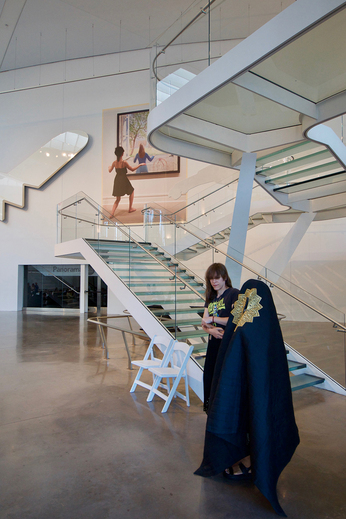
R
E
V N
E
X
T
Drag artist LAWHORE VAGISTAN performed remixed versions of traditional qawwali music, addressing political violence against Muslims in the United States and across South Asia, at the symposium “Fatal Love: Where Are We Now?” at Queens Museum, New York, 2017. Photo by Hrag Vartanian/Hyperallergic.
In 2005, the Asia Society and the Queens Museum of Art in New York presented an exhibition of Indian artists, most of whom were mid-career, titled “Edge of Desire: Recent Art in India.” To complement this exhibition, the latter venue presented a show of 28 South-Asian-American artists, all of whom worked in the Northeastern United States, most of them living in New York. This exhibition, titled “Fatal Love: South Asian American Art Now,” spanned painting, photography and web-based work, but the geographic boundaries were expanded and dissolved to include works by artists of Pakistani, Trinidadian and Bangladeshi descent.
Twelve years later, many of these artists, along with curators and academics, were gathered together by Jaishri Abichandani for a three-day panel, presented once again jointly at the Asia Society and Queens Museum. At the Asia Society, an exhibition curated by Abichandani, “Lucid Dreams and Distant Visions: South Asian Art in the Diaspora,” examined issues of race, nationhood, gender and sexuality as experienced by and interpreted through artists of the South Asian diaspora. The three-day symposium, beginning with a panel at the Asia Society and continuing at the Queens Museum, engaged with one of the most compelling questions of the past century—that of the universal versus the particular. The symposium investigated challenges and themes that are particular to the South Asian diaspora in America, and proposed strategies for resolving these challenges so as to promote anti-racist, anti-sexist and anti-elitist political goals that trumpet universal justice. A prevailing theme of the symposium was the emphasis on visibility—whether it has increased appreciably for South-Asian-American artists in the past decade, and how the question of visibility informs and limits artistic production.
DAY 1
In the opening panel, “Double Duty: Agency and Cultural Production,” Naeem Mohaiemen presented a chart that plotted political organizations, activist groups and art exhibitions in which members of the South-Asian-American community have been involved. This network of cultural workers is both historical—past exhibitions featuring entirely or predominantly South Asian artists, and organizations that are now defunct—and contemporary, demonstrating that the South Asian cultural and artistic community in America brims with vitality and is ever-shifting. Jaret Vadera, commenting on the ability of South Asians to straddle multiple identities and code-switch, insisted on the need for complexity: “We need to resist the urge for quick and easy solutions . . . Binaries are a trap and re-inscribe and recolonize our vision. How do we then protect our communities and build solidarity without essentializing ourselves in the process?”
DAY 2
At the curator’s panel, Anuradha Vikram emphasized the need for building and supporting institutions that respond to the collective needs of a community. Megha Ralapati reinforced this notion of support by addressing the necessity of unlearning individualization in favor of collective practices, using the example of Sajeev Shankar’s study of living root bridges in Meghalaya to illustrate how sustainable structures—such as a bridge formed from the interwoven roots of trees nurtured by a community over the course of several years—are necessary for equitable practices. In a panel titled “Concerning Sculpture,” artists Avantika Bawa, Ruby Chishti and Romy Scheroder explained how each of their individual practices were responsive to their respective environments. A panel on photography and documentation underscored the role of the archive, allowing each of the artists to explore personal histories in the context of larger cultural identities.
DAY 3
The day began with a panel on art in the public sphere, with artists such as Kanishka Raja, Chitra Ganesh and Shahzia Sikander speaking about their collaborative projects with institutions such as schools, governmental organizations, and in the case of Ganesh’s collaboration with Mariam Ghani in Index of the Disappeared (2004– ), public-facing works that placed an emphasis on political transparency through grassroots collaboration in post-9/11 New York. In a panel on faith and artistic practice, Baseera Khan, whose recent exhibition Iamuslima (2017) at New York’s Participant Inc explored her Islamic identity, used French novelist and political activist Jean Genet’s final book Prisoner of Love (1986) overlaid with music, to propose “a revolutionary vision of emancipation through sensuality.” In the queer theorists panel, Allan deSouza suggested that queerness was an essential strategy for decolonizing artistic spaces, while Ronak Kapadia noted that queerness offers the same critique of respectability politics that was central to South Asian American organizing efforts in the 1980s and ’90s. Rounding out the day’s events were performances by LaWhore Vagistan, who combined drag and traditional qawwali music to critique the racial profiling of Muslims in the wake of terrorist attacks in the United States. As with the rest of the symposium, the day’s activities were cognizant of the ways in which South Asian identities were represented and politicized in America, but optimistic in their outlook for how such identities would continue to strengthen through community efforts.
“Fatal Love: Where Are We Now?” took place from June 30 to July 2, 2017, at the Asia Society and Queens Museum, New York.
To read more of ArtAsiaPacific’s articles, visit our Digital Library.






